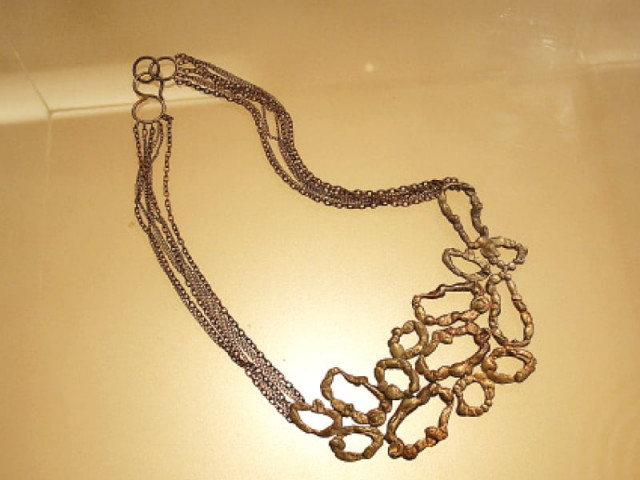BNU thesis display: Meshing the traditional with contemporary
Everything from women’s perceived roles to qawwali music portrayed through fabric.

Everything from women’s perceived roles to qawwali music
portrayed through fabric.
A thesis project display by students of the Mariam Dawood School of Visual Arts and Design at the Beaconhouse National University (BNU) in the textiles and jewellery design disciplines, opened at the Tarogil Campus on Sunday. The display will continue till May 30.
Nayab Yousaf, 22, says she was inspired by ralli, the traditional craft of quilt making in Sindh and south Punjab. She says she wanted to experiment by incorporating contemporary designs and technique into her work. “I wanted to relive this art form in a different medium,” she says. Ralli has matured over time absorbing various patterns and designs, says Yousaf. Her project was lawn furniture patterned with ralli. “I had initially wanted to make a weatherproof tent (shaamiyana) with ralli patterns, but the idea evolved into what it is now,” she says. Her thesis showcases a lawn shed with a traditional jhoola and lawn stools. She says it took her almost three months to design the prototype.
Materials like leather, cotton-satin fabric, and dyed cotton lace were used in the project. Yousaf used machine embroidery, hand appliqué and digital printing to embellish the furniture with rally patterns. She says it cost her Rs78,000 but she believes the product can be commercially produced. In the future Yousaf hopes to focus on outdoor furniture.
Misha Zia, 23, has explored the perceived roles of men and women in the society through the concept of Yin and Yang. Her work portrays her understanding of these roles and the dominance of men in society. “Women are considered malleable,” she explains, “they are expected to mould according to what men and the society require of them.”
Zia says her work portrays women in a society in which men have taken over all areas including education. “Our school curricula portray women as docile creatures in domestic roles, while men are depicted as leaders excelling in various fields,” she says. But the society and women are changing, says Zia.

She has used fabric dyed in various shades of blue, representing water and the amorphous role of women in Pakistan’s society, and barbed wire knotted into the Urdu word, Tu. Zia says she believed that women were subjugated, most of all at the most basic level...verbal. She hopes to continue her.
Rehman Younas says his project was an emotional and spiritual journey that took him two months to complete. He showcases a stretch of woven fibre as a tribute to the qawwali maestro Ustad Nusrat Fateh Ali Khan. The woven piece, he says, depicts the musical notes of Khan’s qawwali ‘Tum Ek Ghorakh Dhanda Ho. He says the notes were divided according to each minute of the qawwali. The weave, he says, represented the emotional tides that he experienced.
“I had been listening to qawwalis for quite some time, but began understanding them only three years ago,” he says.
Yousaf says he preferrs working with synthetic fibres. “I want to take my passion forward,” he says.
As many as five students showcased their projects in the jewellery and accessories department. They were required to display at least seven pieces each.
Noor Mahmood’s ‘luxurious and affordable’ jewellery has “broken the traditional mould,” she says. “My designs make a statement,” says Mahmood. Her project included rings and necklaces priced between Rs3,000 and Rs10,000. The product range, she says, was designed to bridge the gulf between what people wanted and jewellers had to offer.
People usually ignore the difference between jewellery designers and jewellers. “A jewellery designer produces a product, from conceptualising the design to executing it,” she explains.
Mahmood has used copper, crushed stones, semi-precious stones and even silicon in her jewellery. “We need to experiment and infuse unconventional materials to make jewellery,” she says. With traditional jewellery occupying much of the commercial market, she thinks there is a long way to go before such pieces can be offered to a larger clientele.
Published in The Express Tribune, May 28th, 2013.



















COMMENTS
Comments are moderated and generally will be posted if they are on-topic and not abusive.
For more information, please see our Comments FAQ